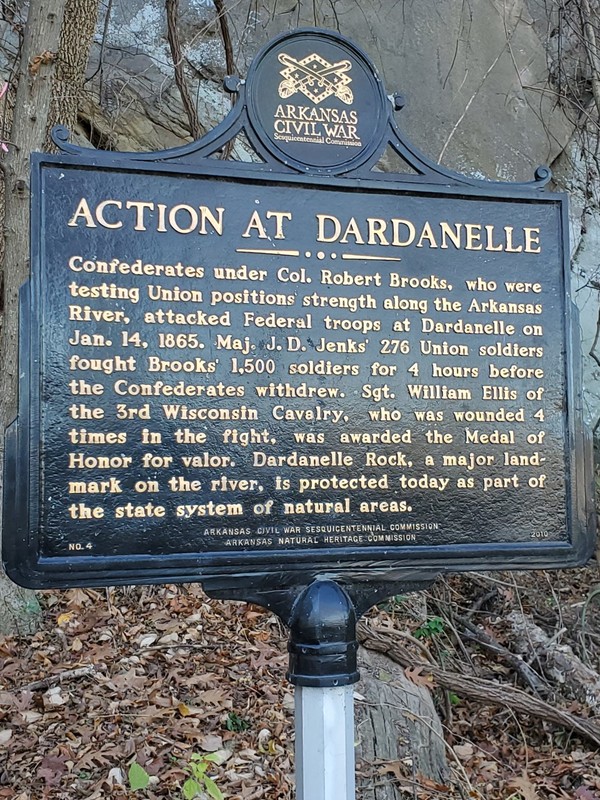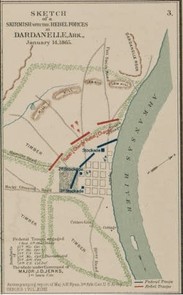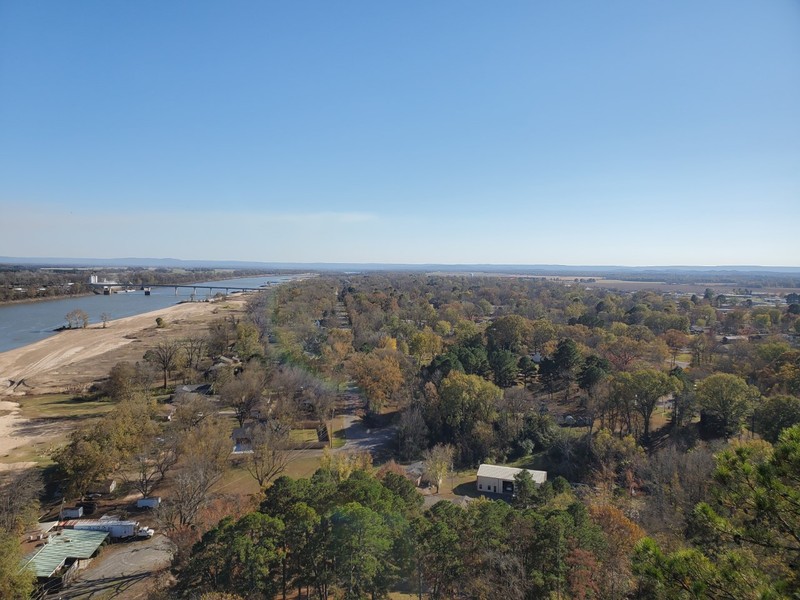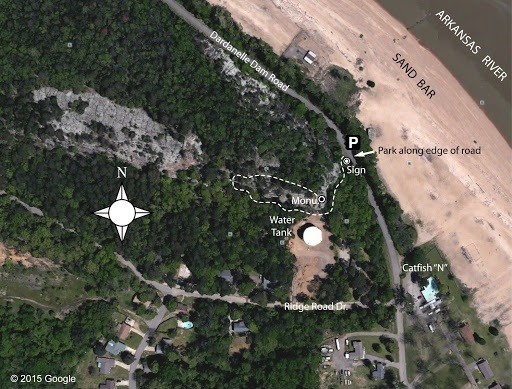Action at Dardanelle
Introduction
Text-to-speech Audio
Images
Marker located at the base of Dardanelle Rock.

Sketch of a Skirmish with Rebel Forces at Dardanelle Rock, January 14, 1865

The view from the top of Dardanelle Rock looking southeast over the battlefield area, which extends to the Arkansas River Bridge.

Overhead Image of the 0.4 mile trail leading to the top of Dardanelle Rock. Climb with Caution: The climb is very steep and has loose rocks in some places. Requires climbers to climb over large rocks and boulders.

Backstory and Context
Text-to-speech Audio
In January 1865, Union forces held control over much of Northern Arkansas and had established multiple encampments along the Arkansas River between Little Rock and Fort Smith. Colonel Abraham H. Ryan of the Union army sent a flotilla consisting of the Ad. Hines, the Annie Jacobs, the Lotus, and the New Chippewa up the Arkansas River from Little Rock to deliver supplies to Fort Smith. Major James D. Jenks of the First Iowa Cavalry and the detachment of cavalry soldiers of the Seventh Army Core in his command accompanied the flotilla on its journey.
Around the same time, Confederate Colonel Robert Brooks* led 1,500 Confederate troops from southwest Arkansas to Dardanelle. His company was comprised of his own men along with cavalry from Colonel Ras. Stirman’s and Colonel Robert C. Newton’s ranks. Their purpose was to occupy the town, assess how strong Union presence was along the Arkansas River, and to maintain control over the South bank.
On January 14, 1865, the flotilla arrived at Dardanelle in the morning and Major Jenks left the flotilla with 276 union cavalry soldiers to occupy the stockades and streets of Dardanelle while the steamboats continued on their course. Jenks and his men manned the earthworks in Dardanelle for four hours before Major Brooks began his attack. Despite being vastly outnumbered, Jenks’ men made use of their two pieces of artillery, trading shots with the Confederates and their single artillery unit for four hours. Brooks withdrew his men at that point in order to pursue the flotilla, which he engaged on its return journey three days later at Ivey’s Ford. Confederate losses totaled 81 while the Union lost about 17 men in this last major conflict between the Union and the Confederacy in Arkansas.
During the course of the battle, a soldier under Jenks’ command, First Sergeant William Ellis (Elise)** showed his courage and valor by remaining at his assigned post after receiving three separate gun-shot wounds, only leaving his post after receiving a fourth wound and a direct order from his commanding officer to seek medical help for his injuries. Ellis was promoted to Second Lieutenant on March 9, 1865 after becoming the first Arkansan to be awarded the Medal of Honor for Valor for his action at Dardanelle.
Today, the area on the south bank of the Arkansas River where this skirmish occurred is built up as a residential area. Dardanelle Rock is located at the west edge of the site and serves as a natural overlook for the battle area. There is a short but steep trail that leads to the top with a commemorative marker which is located at the base of the trail. The marker was placed at the pinned location on the map in 2010 by the Arkansas Civil War Sesquicentennial Commission and the Arkansas National Heritage Commission.
*Colonel Robert Brooks is also referred to as Colonel William H. Brooks at times.
**Though he enlisted as William Ellis, his last name was misspelled as ‘Elise’ on his medal and now appears this way on some official documents.
Sources
Action At Dardanelle, Arkansas Civil War Sesquicentennial Commission. Accessed November 14th 2020. http://www.arkansascivilwar150.com/historical-markers/action-at-dardanelle.
Christ, Mark K.. Action at Dardanelle and Ivey's Ford, Encyclopedia of Arkansas. December 3rd 2018. Accessed October 31st 2020. https://encyclopediaofarkansas.net/entries/action-at-dardanelle-and-iveys-ford-2937/#:~:text=Action%20at%20Dardanelle%20and%20Ivey's%20Ford&text=The%20actions%20at%20Dardanelle%20and,%2C%201865%2C%20Colonel%20William%20H..
Christ, Mark K.. William Ellis (1834-1875), Encyclopedia of Arkansas. March 13th 2020. Accessed October 31st 2020. https://encyclopediaofarkansas.net/entries/william-ellis-5770/.
Gleason, Mildred Diane. Dardanelle and the Bottoms: Environment, Agriculture, and Economy in an Arkansas River Community, 1819-1970. Fayetteville , Arkansas. The University of Arkansas Press, 2017.
The Last Challenge in Arkansas, A Day in the Life of the Civil War. January 14th 2014. Accessed October 31th 2020. http://lifeofthecivilwar.blogspot.com/2014/01/the-last-challenge-in-arkansas.html.
Yell County History, yellcounty.net. Accessed October 31st 2020. https://yellcounty.net/history/history.htm.
Photo taken by Casey Miller on November 17, 2020.
The Last Challenge in Arkansas, A Day in the Life of the Civil War. January 14th 2014. Accessed October 31th 2020. http://lifeofthecivilwar.blogspot.com/2014/01/the-last-challenge-in-arkansas.html.
Photo taken by Casey Miller on November 17, 2020.
Google Image. 2015. http://www.takahik.com/trails/dardrocktrailmappics/dardrock.html
